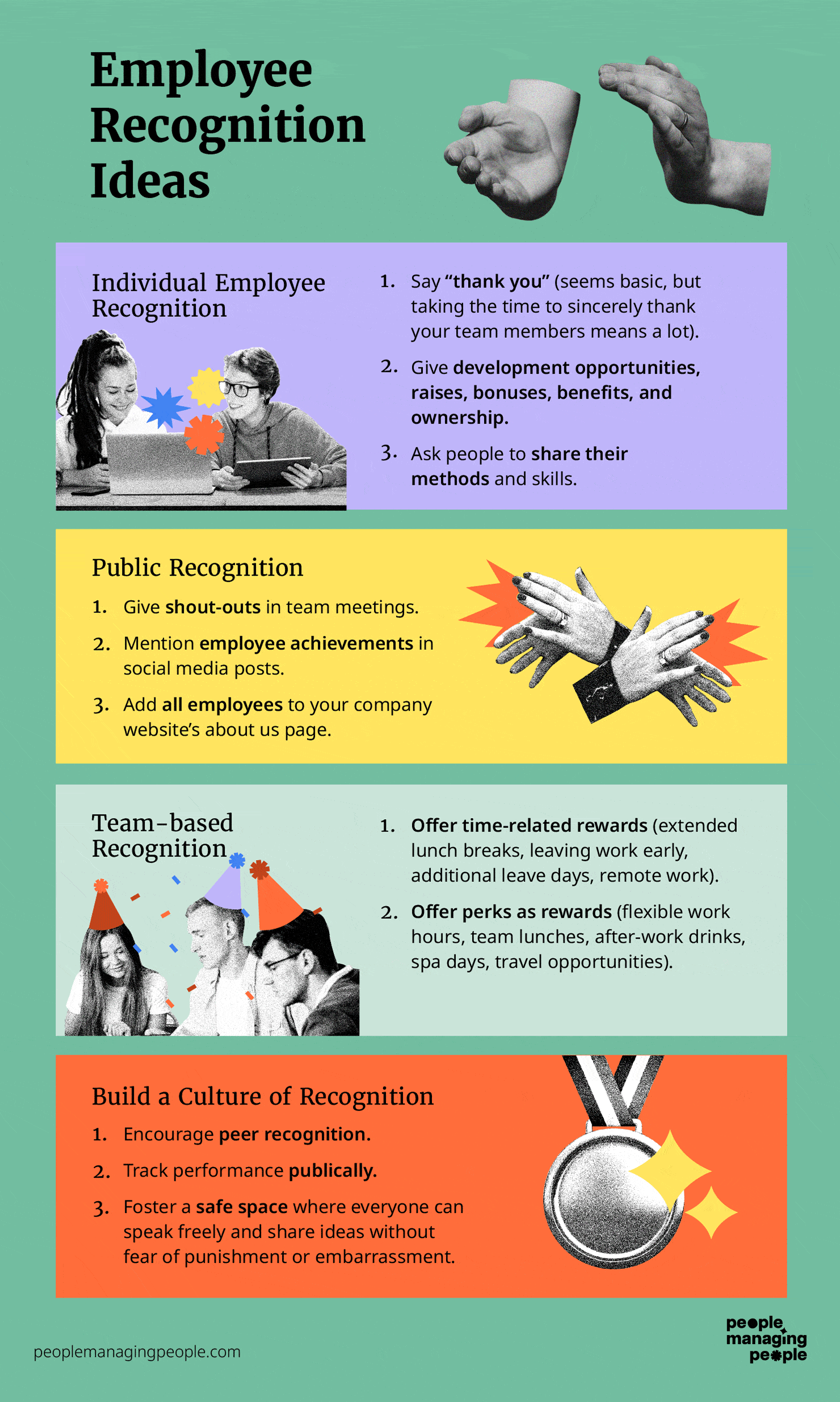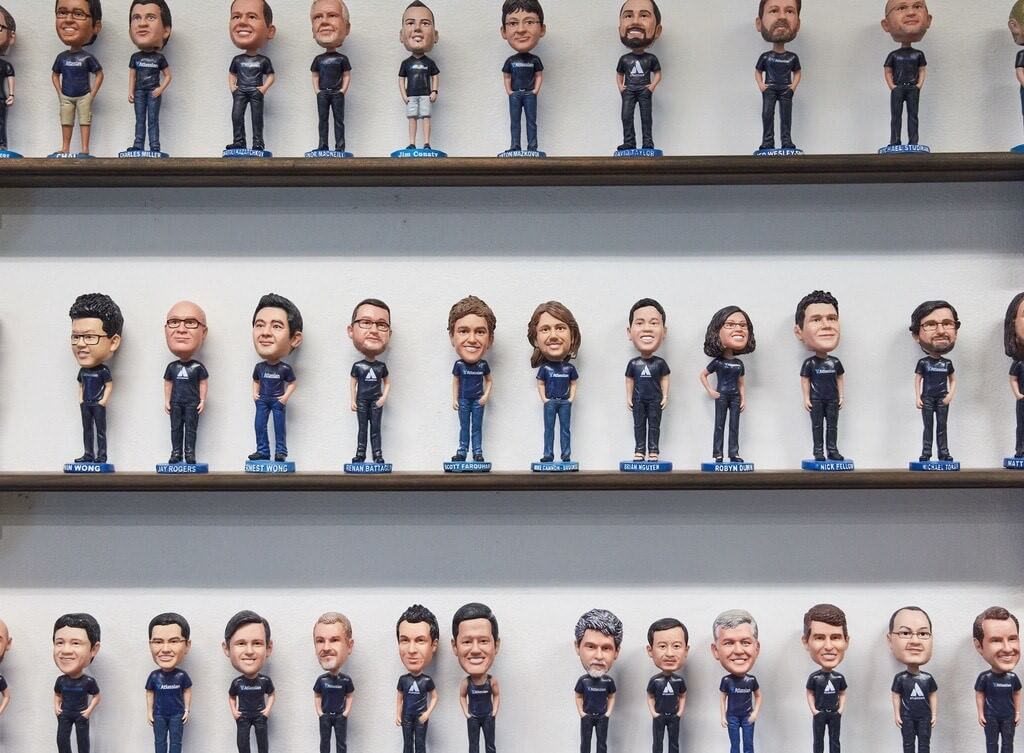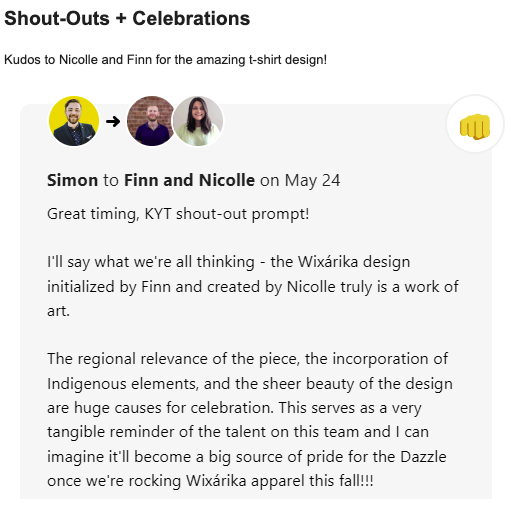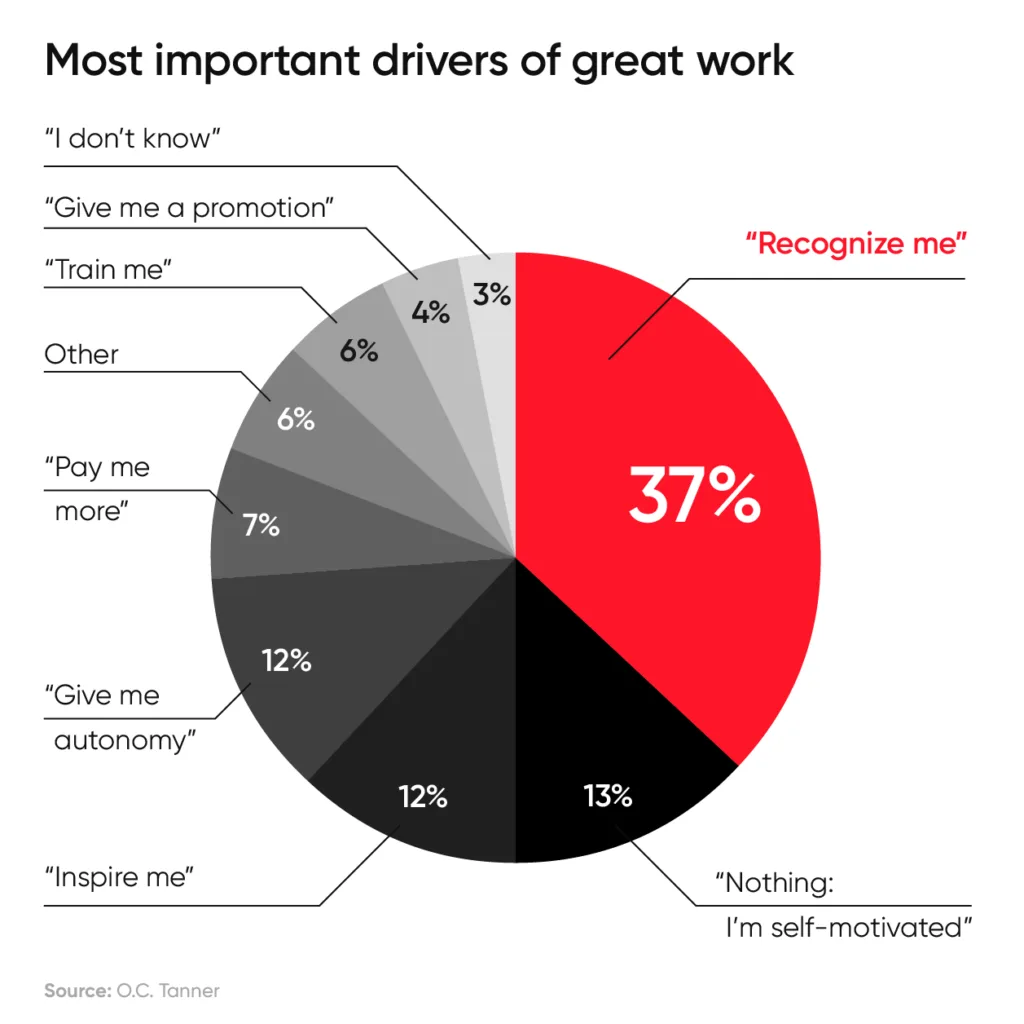Employee recognition is one of the most simple and effective methods of motivating and engaging employees.
Research from Achievers found that employees who are recognized monthly are 36% more likely to say they are productive and engaged, and 22% more likely to be highly committed to their roles.
You can rely on your tech, such as employee recognition software, to help ensure you help people feel valued, but what I want to talk about are the strategic and thoughtful human actions you can take to ensure top performers are recognized.
So here are 20 effective ways to show appreciation for great work to raise employee morale, boost engagement, and build loyalty.
Employee Recognition Ideas
"People work for money but go the extra mile for recognition, praise, and rewards." —Dale Carnegie
Couldn't have said it better myself. Let's get straight into it.

Individual Employee Recognition Ideas
"Recognition doesn’t always have to be big. Simple things like acknowledging someone’s contributions during team meetings, or sending out a company-wide message, can go a long way in boosting morale and making people feel valued.” — Crystal Pinney-Ramos, HR Technology Strategist @ cClearHR
Tailoring recognition to be specific to the individual feels more personal, which typically makes it more meaningful.
Here are some recognition ideas that'll help you create a more engaged workforce and improve employee retention.
1. Say “Thank You”
Seems basic, but taking the time to sincerely thank your team members for their hard work means a lot.
You can do this face-to-face, during a call, or with a thoughtful card, a thank-you note, or a sticky note left in their workspace.
In a remote work environment, send them a thoughtful message on Slack or include a heartfelt thank you in your next video chat.
2. Give Development Opportunities, Raises, Bonuses, Benefits, and Ownership
Financial incentives like raises, bonuses, and benefits like comprehensive healthcare are probably the second most obvious ways to show your staff members that you value them and the work they do.
It says “We appreciate you, so we have no problem compensating you appropriately and providing you with career growth and development opportunities!”.
3. Personalized Gift
Gifts are a tried and tested method to celebrate wins, project milestones, birthdays, work anniversaries, and other important events.
Some gift ideas include flowers, a plant, a gift card, some company swag (like a branded t-shirt), or a nice bottle of wine.
The better you know your employees, the more personalized the gift (or gift card) can be, and the more seen and recognized they will feel. Tech company, Atlassian, makes bobblehead statues for their top performers!

4. Give Employees One-on-One Time With Leadership
According to a Gallup poll, employees are up to three times more engaged when they have regular meetings with their managers. You can take this even further by giving employees one-on-one time with leadership, whether in the form of a short formal meeting, a coffee, or a lunch.
Research from Fractional Insights in 2025 revealed "significance" is a key driver of retention, with 92% of employees actively seeking a greater connection to purpose in their work. One on one time with leaders can help employees develop a sense of significance and connection to the company mission.
In addition to making sure that “the boss knows who they are,” these kinds of meetings can give employees a better sense of their role in the company and a greater understanding of the company’s priorities.
5. Ask People to Share Their Methods and Skills
Asking your best employees to share their knowledge, methods, and skills shows them that you recognize the good work they do. At the same time, it can significantly improve the rest of your team’s competency and effectiveness.
This could take the format of a presentation to the team, a slide deck, or a guideline/process document. You could also involve them in onboarding new employees and/or training more junior team members.
However, be careful that you don’t add too much to their workload without taking other tasks off their plate—after all, you want it to feel like recognition, not punishment.
Public Employee Recognition Ideas
Public praise and validation have the dual benefit of making the recipient feel admired and motivating other employees to strive for the same public recognition.
6. Give Shout-outs in Team Meetings and Via Internal Communication Channels
When a staff member has gone the extra mile and delivered exceptional work, a simple public shout-out can mean the world.
You can do this in your weekly standup, monthly team meeting, or post-project debrief. Employee communication platforms, like Slack, is also a great place to acknowledge good work and give thanks.
7. Mention Employee Achievements in Social Media Posts (Twitter, LinkedIn)
Your company’s social media pages—LinkedIn, Twitter, Facebook, and Instagram—are great channels to publicly call attention to your best employees’ wins and achievements.
Which channel is appropriate will likely depend on the industry you’re in, but LinkedIn in particular is a safe bet for celebrating professional achievement as well as showcasing your employer brand.
8. Give Credit Where Credit’s Due
This may seem obvious, but many companies fail to acknowledge the entire team that contributed to a project’s success, praising the team lead or manager instead of celebrating all the employees who played a role.
When an individual employee plays a vital role in a project and this goes unnoticed, resentment may start to breed. Luckily, this is easy to avoid by building a culture of recognition and giving credit where credit is due.
9. Add All Employees to Your Company Website’s About Us Page
Regularly update your website’s About Us page to ensure that your whole team is represented. This is a simple, low-cost tip, but it can help to make employees feel valued.
10. Mention Successes in Your Company Newsletter
If you have a company newsletter, be sure to use it to mention specific employee successes and thank them for their hard work.

11. Give Employee Recommendations on LinkedIn
On that note, vouching for your employees’ skills and writing them heartfelt recommendations on LinkedIn shouldn’t wait until they’re trying to land a new job.
When you actively build up your employees and recognize their value, they’re less likely to search for a new job in the first place!
Team Employee Recognition Ideas
While individual rewards are important, don’t forget to celebrate your team as a whole. We’ll discuss some of the ways you can do this below.
12. Offer Time-related Rewards
As the saying goes, time is money. What better way to recognize your employees’ hard work than to give them time as a reward?
This can take the form of:
- Extended lunch breaks
- Time for walks during the day
- Late starts to the workday
- Flexitime
- Allowing employees to leave work early
- Additional leave days
- Remote work
"I send people flowers on their last day. Whether you're leaving my team on good terms, or even if you’re being laid off, I send you flowers— keeping that human touch is important." — Liz Lockhart Lance, Chief of Staff @ Performica
13. Pass Along Positive Client/Customer Feedback
When a client or customer offers positive feedback, share it with your team. Everyone likes to know that their work is making an impact and that their contribution is being noticed, especially when they have worked hard to deliver a good result.
14. Offer Perks as Rewards
There are plenty of perks you can offer employees as rewards for doing great work.
Some ideas include:
- Free parking spots
- Flexible work hours
- Remote work
- Team lunches
- After-work drinks
- Pizza parties
- Spa days
- Company retreats
- Travel opportunities
You might consider tying perks to specific milestones, KPIs, or tenure. For example, you might offer a 401K match increase at specific intervals of employment.
You can use employee perks programs to deliver those rewards automatically; just set your systems up, then let them hum along.
15. Host an employee appreciation event
In the US, employee appreciation day is 1st March, and there’s no better day to treat your employees and recognize them for their hard work. Maybe it’s an awards day or a fun outing or offsite somewhere.
Similarly, boss's day is the 16th of October, the perfect opportunity to recognize good leaders with a small token gift or shoutout.
Build a Culture of Recognition to Celebrate Successes Daily
To truly gain the benefits of employee recognition and create a positive employee experience, make recognition a core part of your company culture. Below are some employee appreciation ideas to help you achieve this.
16. Launch an Employee Recognition Program
While sporadic, spontaneous praise has its place, it only allows you to recognize the achievements you’re aware of. Meanwhile, many employees’ hard work may go unnoticed, especially if they’re not the type to broadcast their wins from the rooftops.
Implementing a formal employee recognition program using a dedicated employee recognition system is one way to address this challenge and encourage peer-to-peer recognition across the organization.
17. Encourage Peer Recognition
Encourage employees to celebrate each others’ wins to embed recognition deeply into your culture.
This could include asking employees to nominate their co-workers for special awards or creating a “wins and motivations” channel or platform where team members can shout out their colleagues for performing particular tasks well or thank them for their contributions to specific projects.
One great tool for this is HeyTaco, a peer recognition program that allows employees to reward each other with virtual tacos in public channels in Slack.
These tacos can in turn be redeemed for rewards that you set up, whether they’re gift cards, bonuses, a day off, or whatever you decide to implement. And, because tacos can only be given in group channels, they have the added bonus of promoting public recognition—a powerful reward system.
18. Track Performance Publically
Tracking employees’ performance publicly with tools like a leaderboard or a hall of fame can be an effective way to recognize productivity and effectiveness and motivate employees to work harder—particularly when paired with tangible rewards.
Remember that this type of recognition device is more suited to some types of roles than others and incentivizing competition can have its downsides.
That said, a leaderboard, “employee of the month” award, or hall of fame can be a great way to foster behaviors that embody your company values and contribute to the kind of culture you want to build. For instance, you could track and reward the most active participants in your peer recognition program.
19. Create a Culture of Psychological Safety
Psychological safety refers to the belief that it’s safe to speak up and ask questions, raise ideas, and call attention to concerns without being punished or humiliated. Building a culture of psychological safety in the workplace is vital to creating a space where ideas and collaboration flourish and team members feel supported and seen.
To achieve this positive employee experience, reward participation in discussions with attention and acknowledgment. Praise valuable contributions publicly and ensure that employees (and managers!) understand that there’s no such thing as a stupid question.
Discourage the disparagement of ideas or questions and provide training to address negative management styles to promote psychological safety in your company culture. Remember that most people don’t leave companies, they leave bad managers.
20. Recognize Loyalty by Rewarding Tenure
If you want your employees to remain loyal, recognize and reward tenure whenever possible.
Otherwise, you may send the message that loyalty doesn’t matter, which gives people very little reason to stick around in the long run.
Iowa Cubs owner, Michael Gartner, recently handed out $2,000 bonuses for every year an employee had worked for the team. How's that for motivation?
Also, hire and promote from within whenever possible. At the very least, alert your existing employees of new roles/listings so that they can apply to be considered.
What is Employee Recognition and Why Is It Important?
Employee recognition is simply praising and/or rewarding employees for their contributions. This could be for hard work or another desired behavior, for example upholding the organizational values or contributing to the company culture.
Recognition is an oft-underused part of the performance management process, and it's so effective.
In a recent employee survey, O.C. Tanner asked its staff “What drives great work?” Employees answered in their own words, and the survey found that recognition was the most important consideration for 37% of employees—proof that employee recognition is important and top of mind for employees.

You can monitor and manage whether your employee recognition ideas are really driving impact by using employee engagement tracking software.
To nip ideas that won't work in the bud, keep these best practices front of mind:
Employee Recognition Best Practices
- Certain ways of showing employees recognition will be more applicable to certain types of roles than others. For instance, a leaderboard or a wall of fame may be better suited to sales roles than operations management or HR.
- KPIs are crucial for effectively monitoring, managing, and rewarding your employees’ productivity and effectiveness. These will look different for different industries and roles. At heart, KPIs should allow you to measure what constitutes excellent, average, and below-average performance.
- Be specific. When showing recognition, it will be more effective if it’s attached to a certain behavior. For example, if adaptability is one of your values and a team member showed adaptability when taking on a new scope of work, include that in the praise.
- Show recognition regularly. Obviously, you don’t want to come across as insincere, but regular recognition shared around (not just from one person or for one person all the time) is most effective.
- Recognition should suit the personality and desires of the individual. Everyone’s different and, while some will love the spotlight, others might appreciate less of a fuss. The better you know your employees on an individual level, the better you’ll be able to tailor recognition initiatives to reward them in ways that will be meaningful to them you can always ask too).
- Inject some of your organization’s personality. Employee recognition is the perfect opportunity to have a little fun and show off your organization’s personality. For example, Indian airline IndiGo put their employee of the quarter on the side of a plane! The bonus here is that you're building your employer brand and marketing yourself as a prospective employer while rewarding your star players.



